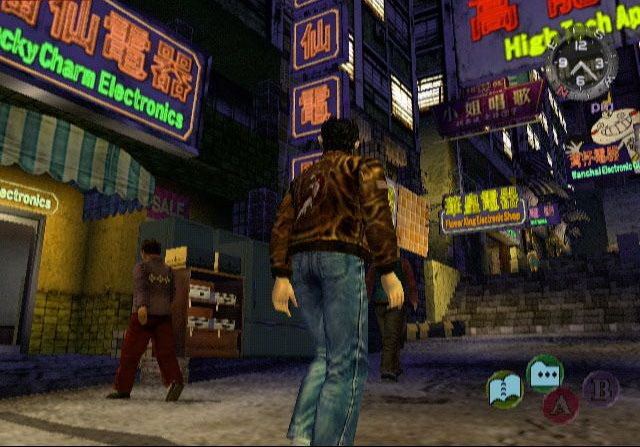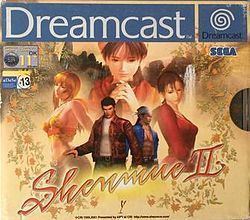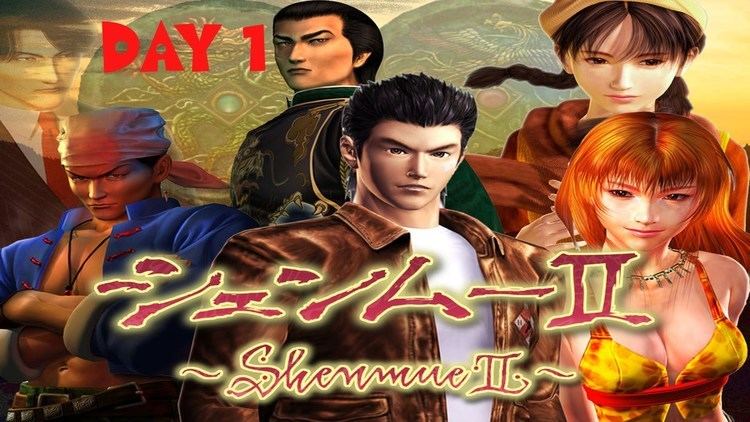8.6 /10 1 Votes8.6
88% Metacritic Mode(s) Single player | 8.7/10 GameSpot 8.3/10 IGN Artist(s) Takehiko Mikami Initial release date 6 September 2001 Series Shenmue | |||||||||||||||||||||||||||||||||
 | ||||||||||||||||||||||||||||||||||
Director(s) Yu SuzukiShinichi YoshinoYoshihiro Okabayashi Writer(s) Yu SuzukiMasahiro Yoshimoto Composer(s) Takenobu MitsuyoshiYuzo KoshiroRyuji Iuchi Similar Shenmue, Shenmue 3, Shenmue Online, Skies of Arcadia, Jet Set Radio | ||||||||||||||||||||||||||||||||||
Super replay shenmue ii episode 2
Shenmue II (シェンムー II, Shenmū Tsū) is an open-world action-adventure video game developed by Sega AM2 and published by Sega for the Dreamcast in 2001. It was directed, produced and written by Yu Suzuki. It is the second game in the Shenmue series, a "revenge epic in the tradition of Chinese cinema", which Suzuki plans to cover at least four games.
Contents
- Super replay shenmue ii episode 2
- Shenmue ii the movie
- Gameplay
- Plot
- Development
- Release and ports
- Reception
- Sequel
- References

Like the original Shenmue, Shenmue II consists of open-world 3D environments interspersed with brawler battles and quick time events. It features a day-and-night system, variable weather effects, non-player characters with daily schedules, and various minigames. The player controls the teenage martial artist Ryo Hazuki as he arrives in Hong Kong in 1987 in pursuit of his father's killer. His journey takes him to Kowloon and the mountains of Guilin, where he meets a young woman who is part of his destiny.

Some of Shenmue II was developed alongside the original Shenmue, the most expensive video game ever developed at the time; Shenmue II was completed for "a much more reasonable sum". The Dreamcast version was only released in Japan and Europe; Microsoft secured the exclusive rights in North America for Shenmue II, and released an enhanced port for the Xbox console in 2002 and other territories in 2003.

The Dreamcast version of Shenmue II received positive reviews, but reviews for the Xbox port were mixed. Despite appearances in several "greatest video games of all time" lists, Shenmue II sold poorly and further games in the series entered a period of development hell lasting over a decade. In 2015, Suzuki and his company Ys Net began developing Shenmue III for Windows and PlayStation 4 following a successful crowdfunding campaign, having licensed the series from Sega.

Shenmue ii the movie
Gameplay
Like the original Shenmue, the player controls teenage martial artist Ryo Hazuki in his journey for revenge. Most of the game is spent exploring the game's open world, searching for clues, examining objects and talking to non-player characters for information. The game features a 3D fighting system similar to Sega's Virtua Fighter series; Ryo can fight multiple opponents at once, and can practice moves to increase their power. In quick time events, the player must press the right combination of buttons at the right moment to succeed. The game includes several minigames; Ryo can spend money on things including capsule toys or arcade games, and Shenmue II includes the 1987 game After Burner.
Shenmue II adds several features. Ryo can ask for directions from passers-by, and fast-forward the game's clock when waiting for a scheduled event to occur, such as a shop opening or character arriving. Unlike the first Shenmue, taking a job is not part of the main story, and the player can choose how to earn money – for example, by gambling, arm wrestling, street fighting or running a pachinko stand. The Dreamcast version of Shenmue II allows the player to import their save data from Shenmue, transferring money, items and martial arts moves.
Plot
In 1987, teenage martial artist Ryo Hazuki arrives from Japan in Wan Chai, Hong Kong on the trail of his father's killer, Lan Di, of the criminal Chi You Men organization. He searches for Master Lishao Tao, the only link to the whereabouts of Yuanda Zhu, a martial arts expert who sent Ryo's father a letter warning him of Lan Di's intentions. When Ryo finds Tao, whose real name is Xiuying Hong, she refuses to help, considering his quest for vengeance reckless. The two part ways, but Xiuying continues to monitor Ryo's progress.
Ryo encounters Wuying Ren, the wily leader of a street gang. Ren decides to help Ryo after deciding there may be money to be made in Ryo's mysterious phoenix mirror; Lan Di took the second mirror, the dragon mirror, when he killed Ryo's father. Wong, a street boy who admires Ren, and Joy, a free-spirited motorcyclist, assist Ryo in his journey.
Ren informs Ryo that Zhu is hiding from the Chi You Men in Kowloon Walled City, a densely populated, crime-ridden enclave of Hong Kong. They locate Zhu there but are ambushed by the criminal Yellow Head organization and Zhu is kidnapped. Ryo and his allies infiltrate the Yellow Head headquarters, but Wong and Joy are captured. Ryo rescues Joy by defeating a powerful martial artist. On the rooftop of the Yellow Head building, Ryo rescues Wong and Zhu from the Yellow Head leader, Dou Niu, as Lan Di departs by helicopter.
At Ren's hideout, Zhu reveals that Lan Di killed Ryo's father because he believes Iwao killed his own father. He also reveals that the mirrors will lead to the resurrection of the Qing Dynasty, the last imperial dynasty of China. Zhu advises Ryo to continue his search in Bailu Village in Guilin, where he says Lan Di is also heading.
In the mountains of Guilin, Ryo rescues a young woman named Shenhua Ling, who has dived into a raging river to rescue a deer. Shenhua's family is connected to the legacy of the mirrors, and she seems to have magical abilities. They walk through the mountains to her village. At Shenuha's family home, a tree named Shenmue (Chinese for "sedge tree") is in bloom; she explains that her name means "flower of the Shenmue tree". The pair go to a stone quarry on the village outskirts to meet Shenhua's father, but find he is missing. They discover a cryptic note and sword; Ryo combines the sword with the phoenix mirror, triggering a device that reveals a large mural of the dragon and phoenix mirrors.
Development
Like the original Shenmue, Shenmue II was developed by Sega AM2 and directed by Yu Suzuki, who had created several successful Sega arcade games including Hang-On, Out Run and Virtua Fighter. Some of Shenmue II was developed in tandem with the first Shenmue, which was most expensive video game ever developed at the time, reported to have cost Sega $70 million; in 2011, Suzuki said the figure was closer to $47 million including marketing. Shenmue II was "completed for a much more reasonable sum".
Release and ports
Shenmue II was released for Dreamcast in 2001 in Japan and Europe. The Japanese version included a "Virtua Fighter 4 Passport", promoting Sega's upcoming Virtua Fighter 4. By 2003, the Dreamcast version had sold 100,000 copies, a tenth of the original game's sales.
Microsoft secured the exclusive rights in North America for Shenmue II and released an enhanced port for the Xbox console on October 28, 2002. The port features an additional camera mode, optional filter effects, improved frame rate and lighting, and English-language voice acting. It also contains an additional DVD with Shenmue: The Movie, a compilation film comprising cutscenes from the original game, previously released in Japanese theaters.
Reception
The Dreamcast version of Shenmue II received positive reviews. GameSpot found that it was "so much better than its predecessor, refining nearly every aspect of the original", with improved pacing and an "epic feel". Tom Bramwell of Eurogamer felt it was "probably the best swan song the Dreamcast could hope for" and took the console "to the very brink of its capabilities".
Reviews of the Xbox version were mixed. IGN praised the game's story, but criticized the English-language voice acting and found the graphics lacking compared to other Xbox games. Eurogamer's Martin Taylor criticized it as a "lazy port" and concluded: "Your perseverance with the sluggish pacing can be rewarding, but Shenmue II consistently proves itself an ageing game with ageing looks."
In 2008, Shenmue II was voted the tenth best game of all time in the IGN Readers' Choice "Top 100 Games of All Time" poll. In April 2013, Den of Geek ranked it and Shenmue the joint-best Dreamcast games. In August 2014, Empire ranked Shenmue II the 51st best game of all time.
Sequel
Suzuki plans the Shenmue story to cover at least four games. After the first two Shenmue games failed to recoup their development cost, Shenmue III entered a period of development hell lasting over a decade. In September 2011, Suzuki left Sega to focus on his development studio Ys Net. In June 2015, he launched a successful Kickstarter crowdfunding campaign develop Shenmue III with Ys Net for Windows and PlayStation 4, having licensed the rights from Sega. It is scheduled for release in December 2017.
